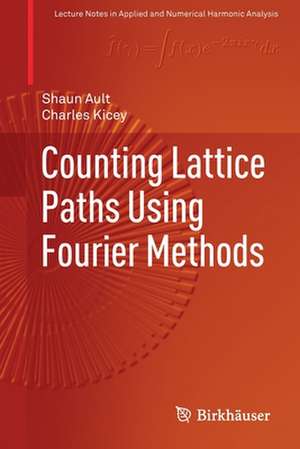Counting Lattice Paths Using Fourier Methods: Applied and Numerical Harmonic Analysis
Autor Shaun Ault, Charles Kiceyen Limba Engleză Paperback – 31 aug 2019
This monograph introduces a novel and effective approach to counting lattice paths by using the discrete Fourier transform (DFT) as a type of periodic generating function. Utilizing a previously unexplored connection between combinatorics and Fourier analysis, this method will allow readers to move to higher-dimensional lattice path problems with ease. The technique is carefully developed in the first three chapters using the algebraic properties of the DFT, moving from one-dimensional problems to higher dimensions. In the following chapter, the discussion turns to geometric properties of the DFT in order to study the corridor state space. Each chapter poses open-ended questions and exercises to prompt further practice and future research. Two appendices are also provided, which cover complex variables and non-rectangular lattices, thus ensuring the text will be self-contained and serve as a valued reference.
Counting Lattice Paths Using Fourier Methods is ideal for upper-undergraduates and graduate students studying combinatorics or other areas of mathematics, as well as computer science or physics. Instructors will also find this a valuable resource for use in their seminars. Readers should have a firm understanding of calculus, including integration, sequences, and series, as well as a familiarity with proofs and elementary linear algebra.
Din seria Applied and Numerical Harmonic Analysis
-
 Preț: 399.29 lei
Preț: 399.29 lei - 20%
 Preț: 673.02 lei
Preț: 673.02 lei - 17%
 Preț: 431.76 lei
Preț: 431.76 lei - 19%
 Preț: 443.08 lei
Preț: 443.08 lei -
 Preț: 412.57 lei
Preț: 412.57 lei - 15%
 Preț: 550.04 lei
Preț: 550.04 lei - 15%
 Preț: 653.98 lei
Preț: 653.98 lei - 18%
 Preț: 1014.28 lei
Preț: 1014.28 lei - 15%
 Preț: 647.92 lei
Preț: 647.92 lei -
 Preț: 413.37 lei
Preț: 413.37 lei - 15%
 Preț: 648.74 lei
Preț: 648.74 lei - 15%
 Preț: 654.77 lei
Preț: 654.77 lei - 15%
 Preț: 636.80 lei
Preț: 636.80 lei - 15%
 Preț: 532.89 lei
Preț: 532.89 lei - 15%
 Preț: 646.62 lei
Preț: 646.62 lei - 15%
 Preț: 653.98 lei
Preț: 653.98 lei -
 Preț: 397.38 lei
Preț: 397.38 lei - 15%
 Preț: 656.43 lei
Preț: 656.43 lei - 15%
 Preț: 661.97 lei
Preț: 661.97 lei - 18%
 Preț: 957.13 lei
Preț: 957.13 lei - 24%
 Preț: 829.74 lei
Preț: 829.74 lei -
 Preț: 398.35 lei
Preț: 398.35 lei - 20%
 Preț: 569.86 lei
Preț: 569.86 lei -
 Preț: 392.21 lei
Preț: 392.21 lei - 18%
 Preț: 1121.76 lei
Preț: 1121.76 lei - 18%
 Preț: 1001.32 lei
Preț: 1001.32 lei -
 Preț: 387.75 lei
Preț: 387.75 lei - 15%
 Preț: 653.98 lei
Preț: 653.98 lei - 20%
 Preț: 567.32 lei
Preț: 567.32 lei - 20%
 Preț: 573.77 lei
Preț: 573.77 lei -
 Preț: 406.80 lei
Preț: 406.80 lei -
 Preț: 387.38 lei
Preț: 387.38 lei - 5%
 Preț: 1168.71 lei
Preț: 1168.71 lei -
 Preț: 400.85 lei
Preț: 400.85 lei -
 Preț: 398.15 lei
Preț: 398.15 lei - 15%
 Preț: 644.49 lei
Preț: 644.49 lei - 19%
 Preț: 575.84 lei
Preț: 575.84 lei - 15%
 Preț: 703.71 lei
Preț: 703.71 lei - 20%
 Preț: 334.71 lei
Preț: 334.71 lei - 15%
 Preț: 525.54 lei
Preț: 525.54 lei -
 Preț: 405.06 lei
Preț: 405.06 lei - 15%
 Preț: 536.96 lei
Preț: 536.96 lei
Preț: 463.85 lei
Preț vechi: 545.71 lei
-15% Nou
Puncte Express: 696
Preț estimativ în valută:
88.79€ • 96.47$ • 74.63£
88.79€ • 96.47$ • 74.63£
Carte tipărită la comandă
Livrare economică 21 aprilie-05 mai
Preluare comenzi: 021 569.72.76
Specificații
ISBN-13: 9783030266950
ISBN-10: 3030266958
Pagini: 136
Ilustrații: XII, 136 p. 60 illus., 1 illus. in color.
Dimensiuni: 155 x 235 mm
Greutate: 0.22 kg
Ediția:1st ed. 2019
Editura: Springer International Publishing
Colecția Birkhäuser
Seriile Applied and Numerical Harmonic Analysis, Lecture Notes in Applied and Numerical Harmonic Analysis
Locul publicării:Cham, Switzerland
ISBN-10: 3030266958
Pagini: 136
Ilustrații: XII, 136 p. 60 illus., 1 illus. in color.
Dimensiuni: 155 x 235 mm
Greutate: 0.22 kg
Ediția:1st ed. 2019
Editura: Springer International Publishing
Colecția Birkhäuser
Seriile Applied and Numerical Harmonic Analysis, Lecture Notes in Applied and Numerical Harmonic Analysis
Locul publicării:Cham, Switzerland
Cuprins
Lattice Paths and Corridors.- One-Dimensional Lattice Walks.- Lattice Walks in Higher Dimensions.- Corridor State Space.- Review: Complex Numbers.- Triangular Lattices.- Selected Solutions.- Index.
Textul de pe ultima copertă
This monograph introduces a novel and effective approach to counting lattice paths by using the discrete Fourier transform (DFT) as a type of periodic generating function. Utilizing a previously unexplored connection between combinatorics and Fourier analysis, this method will allow readers to move to higher-dimensional lattice path problems with ease. The technique is carefully developed in the first three chapters using the algebraic properties of the DFT, moving from one-dimensional problems to higher dimensions. In the following chapter, the discussion turns to geometric properties of the DFT in order to study the corridor state space. Each chapter poses open-ended questions and exercises to prompt further practice and future research. Two appendices are also provided, which cover complex variables and non-rectangular lattices, thus ensuring the text will be self-contained and serve as a valued reference.
Counting Lattice Paths Using Fourier Methods is ideal for upper-undergraduates and graduate students studying combinatorics or other areas of mathematics, as well as computer science or physics. Instructors will also find this a valuable resource for use in their seminars. Readers should have a firm understanding of calculus, including integration, sequences, and series, as well as a familiarity with proofs and elementary linear algebra.
Caracteristici
Introduces a unique technique to count lattice paths by using the discrete Fourier transform Explores the interconnection between combinatorics and Fourier methods Motivates students to move from one-dimensional problems to higher dimensions Presents numerous exercises with selected solutions appearing at the end
